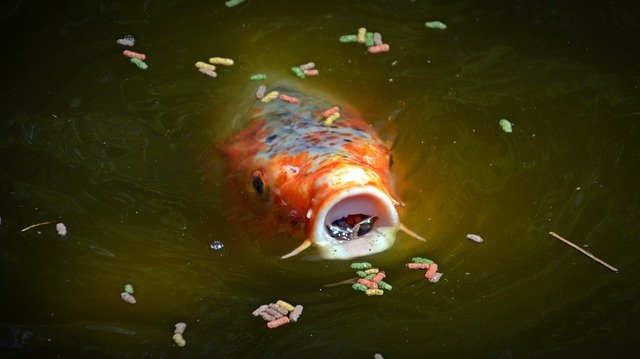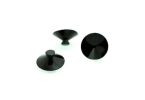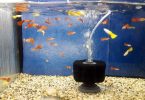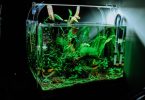Table of Contents
What does a Koi fish eat?
Before I hit the keyboards to share some of my knowledge of “what koi fish eat”, I had to convince myself that the name “Koi” was good enough for the fish and that it was not hilarious.
In all honesty I don’t think the name “Koi” is good enough, but I cannot change the name either, although I like the fact that the name has just three letters. Anyways, nishikigoi is a coloured variety of Amur carp that belongs to the family of Cyprinidae, and is of the Cyprinus genus, while its species is the cyprinus rubrofuscus.
Actually the name of the “Koi” fish is “Nishikigoi”, Koi is just a pet name aquarists gave the fish. Or better still, let’s just say that “Koi” is the informal name of the “Nishikigoi”. You can call it any of the two names, the choice is yours to make.
In this article, I will be sharing with you all you need to know about what koi fish eat, and the feeding habits of the fish. You will also know a lot of other things about the koi fish.
What does the Koi fish or the Nishikigoi fish look like?
Generally, the different species of the koi fish are known for their very vibrant colours, and those colours are the outstanding things about the Koi fish.
However, it is always best to describe fishes like koi fish by their varieties. This is because they usually have very slight differences. So in this section, we will describe the koi fish based on the different species of the koi fish.
- KohakuWhite and orange Kohaku koi fish
- Taisho Sanke
- Showa
1. Kohaku White and Orange Kohaku Koi Fish
First, I must say that the different species of Koi fish or the Nishikigoi have very amazing names. So the first koi fish we will be describing in this section is the Kohaku Koi fish.
The Kohaku koi fish like most species of fish is also named after its colours, the white Kohaku koi fish, and the orange Kohaku fish.
So the Kohaku koi fish or Nishikigoi fish is regarded as the king of all other species of the koi fish. More so, the Kohaku species or type of koi fish was the first species of koi fish that was bred to have double colours, because it was bred with double colours, the orange colour and the white colour.
Again, the Kohaku species of koi fish is simply beautiful, its aesthetic and very majestic appearance definitely makes it the favorite for aquarists in any aquarium, or aquatic tanks, or even koi pond. More so, most of the Kohaku species of Nishikigoi fish have a very yellowish colour of nose.
The body of the Kohaku species or type of koi fish has a white colour that is quite stunning (the Japanese refer to that as shiroji), then it also has blotches that are red in colour, whose effects makes the colour of the Kohaku species share an astonishing uniformity.
Those red blotches are traditionally labeled “hi”, and they are of two types. One of the type of the red markings is the red marking which is tinted purple. These red markings that are tinted purple, are well defined and thick yet as the Kohaku species of the koi fish gets older, the thick red blotches or markings with tints of purple soon begin to fade away, gradually leading to the absence of crisp margins.
This type of red blotches and colour of the species of koi fish are usually very easy to be taken care of. In fact, aquarium beginners or new aquarists with very little experience or even no experience at all could begin with the Kohaku species of koi fish that has red blotches, and are tinted the colour purple.
However, the other type of red marking or red blotches are more familiar among aquarists who are highly experienced. These red blotches are tinted orange-red colour, and have proven to be very difficult to be taken care of. This second type of blotches or red markings are known for a crisp margin that is also very visible between the white colour and the red colour on the body of the Kohaku koi fish. The Kohaku species of koi fish whose red blotches or red markings are tinted orange-red colour are chosen by the aquarists who have great experiences, just as I indicated earlier.
2. Taisho Sanke
The Taisho Sanke species of koi fish or nishikigoi can also be referred to as Taisho Sanshoku or even as Sanke. Sanshoku in Japanese where this is mostly found and bred means the combination of three colors.
From the name, this means that the taisho sanke type of koi fish has three colors on its body. The colours on the body of the sanke type of Koi fish include the following: the red, the black and the white.
It is important to know that the taisho sanke species of koi fish is similar to the Kohaku species of the koi fish, and is just like the Kohaku species of the koi fish, except for the fact that the body Kohaku is white in colour (that is the Japanese shiroji) with blotches or markings that are red in colour (that is called hi by the Japanese).
Now the difference between the taisho sanke species of koi fish and the Kohaku species of koi fish is that the body of the taisho sanke species of koi fish has black blotches or markings as you may prefer to call them (these blotches are called Sumi blotches or markings).
The Taisho Sanke species of the koi fish is classified among a group of the koi fish called ‘Big Three’, in the world of the species of koi fish.
So the head of a Taisho Sanke species of koi fish has two major colours, these colours are the colour white and the colour red; the head of the taisho sanke species of fish is plain and does not have any sumi blotches or markings.
The head of the taisho sanke species of fish creates another difference in the body of the Taisho Sanke species of koi fish and the Kohaku species of koi fish because the Kohaku species have red blotches or markings that begin from the apex part of the head of the Kohaku species, but that of the taisho sanke is very clear.
Also, the base pectoral fins of the taisho sanke species of koi fish is coloured white and it has Sumi blotches or markings.
3. Showa
The Showa species of the Koi fish is also called Showa Sanshoku or Showa Sanke by the Japanese. Remember that in the previous section, or in one of the preceding paragraphs, we mentioned that the sanshoku refers to three colours or combinations of three colours .
However, the Showa species of the koi fish has its name because of the presence of the white colour, the red colour, and the black colour on the body of the koi fish.
Amazingly, the Showa species of the koi fish has a striking resemblance to the taisho sanke.
Now in the midst of resemblance, and similarities, there are also differences. So the major differences between the Showa species of the koi fish and the taisho sanke species of koi fish is the colour of the Showa species of koi fish.
The colour of the Showa species of koi fish is what the Japanese call Karasu (this means black coloured body). The body or the base of the Showa species of koi fish is black, that is the karasu, then Showa has red and white blotches or markings.
Now unlike the taisho sanke species, the Showa species of koi fish has a pattern with colour black that is seen throughout the body of the Showa species of koi fish.
However, the white, the red, and the black-coloured blotches and markings are evenly distributed throughout the body of showa, and it has crisp as well as clean margins between the three colours.
Interesting Facts About the Koi Fish
The species of the koi fish or nishikigoi are very alluring to the sight, hence are amazing to behold. In this section, we will be sharing necessary facts about the koi fish. Aside from what koi fish eat, here are some of the amazing facts you should know about the koi fish.
- Koi pond
- Cold climate
- Japanese culture
- Koi goldfish
Koi Pond
The Koi pond is the name given to the place where the species of koi fish live. So you should know that if you are looking to find species or different types of koi fish, you will definitely find them in koi ponds where they swim together.
The koi ponds of the species or different types of koi fish are very popular and well known among aquarists around the world. And like I said earlier, you will always find these species of koi fish swimming in the koi ponds everywhere in the world.
Cold Climates
Cold waters are the natural habitat of species of the Amur carp family, which is the reason the indoors variations have dispositions that may appear hardy because the indoor waters are not very cold. But in the outdoors, the species of koi are calm and have a very appealing disposition.
Japanese Culture
Remember that Koi fish and all of its different species are commonly found in Japan hence are synonymous to the Japanese.
The calm nature of the koi fish especially when in its natural habitat is very calm and so is symbolic to the japanese. For them, the Koi fish or the nishikigoi symbolizes immense affection and love.
Koi Goldfish
The koi goldfish is an artificial breed of the koi fish made from the seventeenth century. This species of koi fish is an amazing fact especially in comparison to the goldfish. Although the goldfish was first bred before the species of the koi goldfish.
Koi Care
Caring for the species of Koi fish is not usually a problem, you just need to be able to provide an adequate sized and well maintained aquatic tank, habitat, or pond, as well as a nutritious source of food. Ensure that you monitor the level of oxygen and the PH or alkaline level of your pond so as to keep your fish safe from any ailment. Carefully clean up all the time.
Behavior of the Koi
The Koi fish may appear to be graceful, calm, swimming along the surface of the pond, but sometimes the natural foliage of the koi fish sinks it to the depth of the water. The koi fish live in ponds and hunt for meals. They love to feed and it reflects in their behaviour.
Reproduction of the Koi
The reproduction of the species of koi fish does not have any protocol. When it is breeding time, the male koi fish usually follows the female koi fish until they release their eggs. Now the fertilization of the eggs by the male begins after the release of the egg. After fertilization, the eggs drift to the bottom part of the pond and then hatch within seven to ten days.
The baby koi fish or any fish at all is called the fry, and it has a low rate of survival. This could also account for the multiple eggs of this, females produce several thousand eggs when they breed. The female koi fish and the male koi fish do not care for the young in anyways.
Feeding and Diet of the Koi Fish
While in the natural habitat, the koi fish feeds on algae, on plants, on insects, on worms, on seeds, and on anything they find in the pond. This means feeding time is simply a way to bond and have fun with your fish.
What You Can Feed Koi Fish
What do koi fish eat; fish feeds and flakes, and also on anything humans feed on. Here are the four most nutritious meals you can feed the koi fish:
Spirulina Algae
This comes in tablet form and is very healthy to feed the koi fish. They inhabit water and produce their food. This type of algae is usually free-floating and can mostly be found in lakes with high levels of pH and hard water.
Here is why you should feed the koi fish spirulina algae:
- For an increase in the rate of growth
- To aid digestion
- Boost its immune system
- It helps prevent its abdomen from swelling.
- To enhance the production of enzymes that dissolve fats to energy
- To bring out good colour through pigments of carotene pigments in algae
Wheat Germ
This is one of the best feeds your koi fish can eat. I know germ sounds irking, but this is not a bad germ. The wheat germs is that wheat part that springs up and then grows to a new plant, some call it the wheat seed.
It has been proven that the wheat germ boosts the growth of the koi fish. More so, the wheat germ is a natural means or source of the vitamin E and it aids in the circulation of blood. The wheat germ also increases the flow of nutrients and oxygen, as well as promotes balanced growth, and helps to fight off diseases.
Brine Shrimp
Brine shrimp is another interesting feed called the bio-enrichment often filter water in their process of feeding which has nothing to do with their size. They are highly nutritious because the nutrients they feed are usually transferred to the fish.
Fish Food
Flake or Fish food is best served to smaller koi fishes, and in small bits. Pellets are also examples of flakes and also part of the food the koi fish likes. Other foods they love to eat include: Clams, larvae, worms, tadpoles, and shrimp.
What Not To Feed Koi Fish
You already know what koi fish eat, here’s what you should not feed the fish:
- You should not feed the fish any food too rich in carbohydrates.
- Do not feed the Koi fish any atom of peas, corn, and white bread.
- Also do not play with the koi fish when you are feeding the koi fish.
- Please do not feed the koi fish game from the wild. Some of which include the following: fish, frogs, bugs, and any other thing from the wild. Because such meals could be contaminated, and the animals could be sick or have parasites.
- Also, do not feed the koi fish grains, as grains could make them fat, except your fish happens to be losing weight.
- Do not feed them rice or pasta. If you must do so, then you will have to cook them but it has to be free of salt so that the food does not expand within the koi fish.
How To Feed Koi Fish
You can feed the Koi fish with your hands. Here is how you should do that.
- First slice the bigger foods in smaller sizes.
- Then, throw a handful of the sliced bits in the koi pond.
- Allow the koi fish to eat the food well enough, at least almost to finish before tossing another handful of the meal.
- Clean up the pond by taking away any remaining food from the pond. The essence of throwing it away is so that it does not dissolve and contaminate the water, or reduce the quality of the water.







